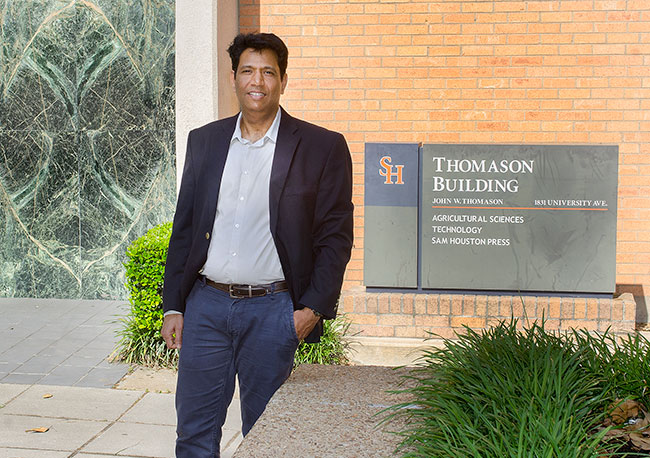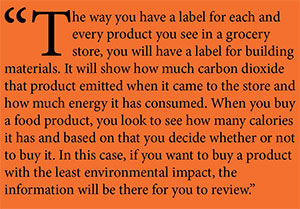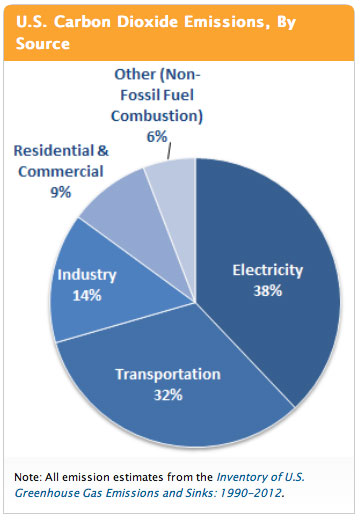Prof Joins International Committee Working To Remove �Fa�ade� Of Buildings, Energy Consumption
April 24, 2014
SHSU Media Contact: Jennifer Gauntt
Story By: Amy Barnett
 |
| SHSU assistant professor of industrial technology Manish Dixit has been named the sole U.S. representative for Annex 57, an international project working to standardize the way embodied energy is calculated around the world and to create a carbon database. Through the database, Dixit hopes a labeling system will be created that will allow consumers to understand the carbon footprint of the materials they purchase and make consumers more environmentally conscious. —Photo by Brian Blalock |
Stopped at a red light, you can barely see past your windshield because of the dark gray exhaust billowing from the car in front of you. You’re not a scientist, but you know that’s not good for the environment.
You see it again as you drive through a coastal town in southeast Texas. This time, dark smoke rises from the stacks of an oil refinery and fugitive emissions leak from the equipment within the plant; you see it and smell it, and you’ve heard for years that it has a major impact on the air we breathe.
Transportation and industry are well-known culprits in the discussion of pollution, and they receive more than a mere mention in the debate of global warming.
Transportation produces about 28 percent of all U.S. global warming or greenhouse emissions, according to the Environmental Protection Agency. Industry, including power plants and oil refineries, is responsible for 20 percent; electricity generation is responsible for 32 percent; and commercial and residential use and the agriculture sector each make up 10 percent.
In addition, the EPA reported that in 2012, carbon dioxide accounted for more than 80 percent of all U.S. greenhouse gas emissions from human activities. Transportation, industry and the combustion of fossil fuels to generate electricity, combined, are responsible for 84 percent of the carbon dioxide put into the atmosphere each year.
While we often can see the pollution that is believed to contribute to the global warming phenomenon, some offenders likely go unnoticed by most people; carbon dioxide emissions from a shopping mall, an office building and a neighborhood of new homes may never cross your mind.
 Standing outside buildings in India, it never crossed the mind of Manish Dixit, SHSU assistant professor of industrial technology, either. That is, until he became an architect.
Standing outside buildings in India, it never crossed the mind of Manish Dixit, SHSU assistant professor of industrial technology, either. That is, until he became an architect.
“I worked in India as an architect for four years. I designed buildings and supervised the construction. When I was doing that I started seeing a lot of material being wasted–a lot of concrete, brick, steel,” Dixit said. “I thought to myself, ‘Where is this going? Is this the way we want to continue?’
“When I decided to further my education, I decided to do research on this topic: how much energy is going into these materials? When we are demolishing a building and constructing a new one, how much energy is being wasted?”
He began thinking in terms of embodied energy, the sum of the total amount of energy required to produce any goods or services—something most people don’t often think about.
“When you consume anything, you consume energy. The bread you eat for breakfast or the tortilla you eat for lunch has energy attached to it,” Dixit said. “So when the bread is produced, when the wheat was grown in the agricultural field, from there to your plate, it has consumed energy and that’s why it has some contribution to carbon emissions.”
Dixit focused his research on the environmental impact of the embodied energy of buildings. In this case, he considered the total energy required for the extraction, processing, manufacturing and delivery of building materials to a building site.
“In certain buildings you have a variety of materials; each material consumed energy when it was manufactured and caused some carbon emission. Energy was used to transport the material to the construction site, and when the building is in use, it will use a lot of energy,” Dixit said. “So how do we quantify the total energy embodied in a building and how that relates to the how much carbon is put into the atmosphere because of the building?”
Dixit said there are currently four or five methods being used around the world to determine the embodied energy of a building and its affect on the atmosphere. It is expressed in megajoules or gigajoules per unit weight or area, and the process of calculating the embodied energy is complex and involves numerous sources of data.
An international project known as Annex 57 is focusing on making the process easier by providing a standardized method to calculate and analyze the energy embodied in building construction.
Annex 57 comprises 28 participants from various countries, including Dixit, who received approval by the U.S. Dept. of Energy this year to take part in the research and represent the United States.
“I will be contributing to the establishment of a standard embodied energy and carbon calculation method, embodied energy and carbon database for construction materials and a set of measures to reduce the life cycle energy consumption of buildings,” Dixit said.
*Chart from EPA.gov |
Dixit anticipates that a standard evaluation method and a carbon database will provide the tools needed to create a system of environmental labeling.
“The way you have a label for each and every product you see in a grocery store, you will have a label for building materials. It will show how much carbon dioxide that product emitted when it came to the store and how much energy it has consumed,” Dixit said. “When you buy a food product, you look to see how many calories it has and based on that you decide whether or not to buy it. In this case, if you want to buy a product with the least environmental impact, the information will be there for you to review.”
Dixit hopes placing a label on building supplies will make consumers more environmentally conscious.
“When you know how much energy goes into manufacturing each brick, you will not want to demolish a building. Hopefully, you will want to reuse it as much as possible,” Dixit said. “And when you are constructing a new building, environmental labeling will make you resource efficient.”
The EPA states that reducing the energy use and greenhouse gas emissions produced by buildings is fundamental to the effort to slow the pace of global climate change. Dixit agrees that “slowing” the climate change is possible, but he believes avoiding it is no longer an option.
“It is already happening,” he said. “There is some argument against it, but we have seen with the polar ice caps how the volume has been reduced in the last 15 years. Ice is melting, so there is some change in the climate pattern.”
The next time you are involved in a construction project, whether it’s building a new home, an outdoor deck, or even a tree house, Dixit hopes you will consider the embodied energy of each piece of material you are using.
Using recycled materials or materials produced close to your building site will reduce the greenhouse emissions associated with your project and have a direct impact on the environment, according to the EPA.
“When millions of people are making smart decisions, a lot of carbon can be saved,” Dixit said.
Annex 57 plans to have a standardized method to calculate the embodied energy of building construction by 2016.
- END -
This page maintained by SHSU's Communications Office
Associate Director: Julia May
Manager: Jennifer Gauntt
Located in the 115 Administration Building
Telephone: 936.294.1836; Fax: 936.294.1834
Please send comments, corrections, news tips to Today@Sam.edu.

 SamWeb
SamWeb My Sam
My Sam E-mail
E-mail


